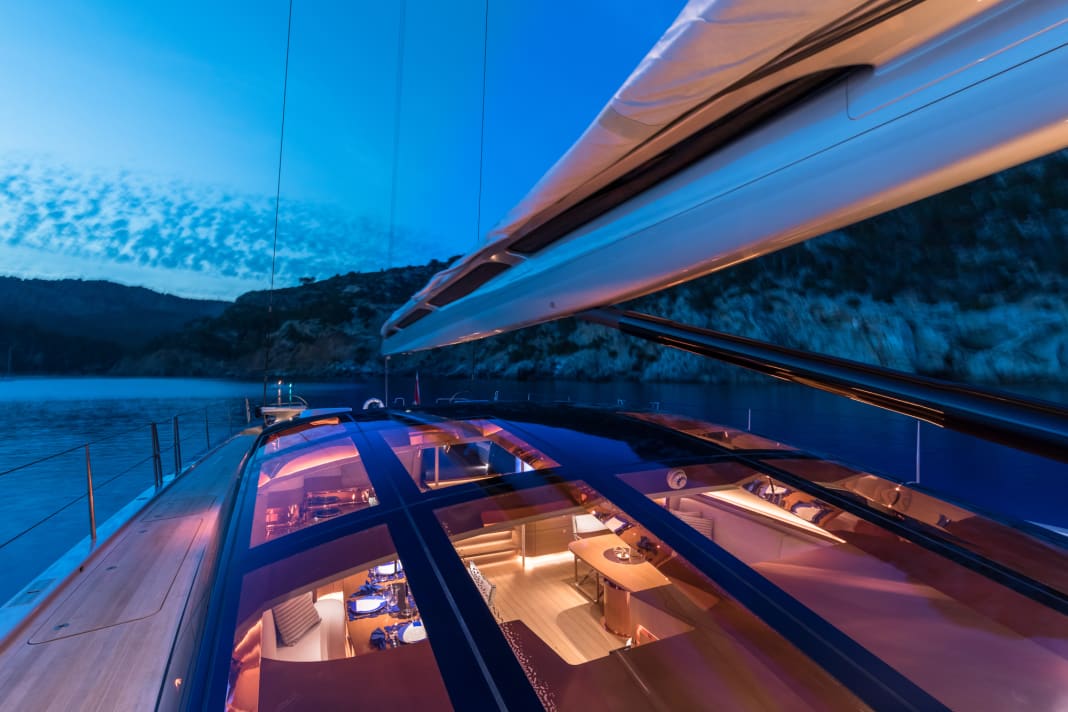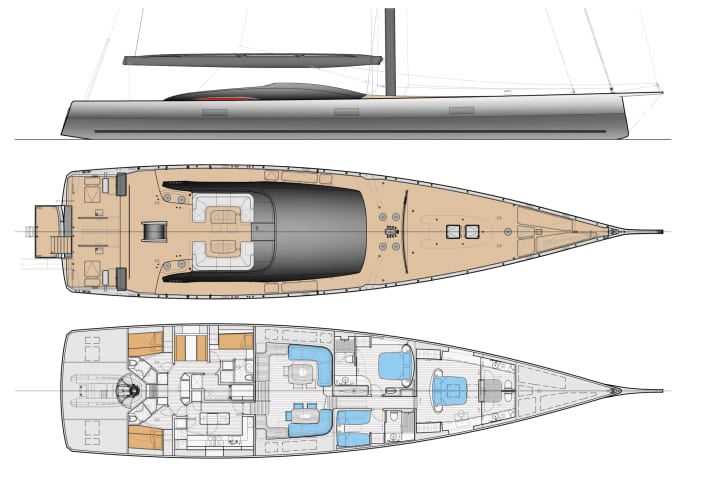





First place in the Supermaxis: the first regatta year could not have ended more beautifully than with a victory in September 2017 off Porto Cervo. Paola and Salvatore Trifirò also beat the fast "Inoui" with their new 32-metre "Ribelle": 4th place. The Trifiròs were both amazed and delighted by this success: "We wanted something more manoeuvrable, faster, with a smaller crew. And now this success: the icing on the cake," said a delighted Paola Trifirò on the Piazza Azzurra in front of the clubhouse of the Yacht Club Costa Smeralda. They had already trained for this victory in June with two second places in their class at the Loro Piana Cup off Porto Cervo and the Palma Superyacht Cup. Here's to a Spumante from Trentino!
The Trifiròs were inspired not least by "Inoui" when considering a fast new build. The 33-metre Briand design was launched by Vitters in Zwartsluis in 2013, the fourth carbon composite project from this shipyard. The hull was manufactured by Vitters' sister company Green Marine in New Forest near Southampton. That was a good fit. Because his previous new build, the Dubois design "Zefira", 370 tonnes of aluminium with a length of 50 metres, had been delivered to the Italian lawyer couple Fitzroy Yachts from New Zealand. The Milanese did not want to repeat the distance to the Pacific. So there was hardly anything more obvious to the Trifiròs than to commission the next new build, this time a decidedly lightweight, from Vitters in a 32-metre format, making it significantly smaller and decidedly more manageable in carbon fibre.
They had met their designer at Ed Dubois. Back then, Malcolm McKeon, as the right-hand man of the master of large sail performers, had helped them to achieve attractive speeds even on large slips.
A major change of heart for "Ribelle"
Where did this change of heart come from, switching from a large performance cruiser for long trips to a lively regatta whirlwind for short, hot distances? With their intention to downsize, the Trifiròs were clearly going against conventional experience, which shows that the dinghy of childhood and youth was followed by regatta boats with a keel and that one day comfort gained the upper hand over sporting ambition. The length and weight of the yachts grew, apart from small slips over this or that regatta course with party character and bucket-list pleasure. The fact that this evolution is then followed by the metamorphosis of the sailor into the owner of a veritable motor yacht is said to have already happened and needs no apology. The barrier-free sea with comfort dune is still waiting to be invented.
However, the Trifiròs felt a different urge than that of increasing comfort - with one probably typically Italian exception, which will be discussed later. They wanted to be back on the road as they were as students, close to the sea and in touch with the elements. The "Ribelle" project could well be described as a fountain of youth, saturated with the experiences and desires that a long sailing life brings. This decision deserves congratulations with a sparkling 823 Maso Michei from Giuseppe Tognotti, also from Trentino.
The downsizing of the format compared to "Zefira" also involved reducing the crew from eight to five. On tours before and after regattas, this core crew is enough to bring a self-tacking jib and headsails furled by Reckmann up and downwind. For regattas, the crew, which then grows to around two dozen, manages the large space sheets.
Unobstructed view for suites and sloping teak deck
Being different and yet elegant - this is not only how the winegrowers of the Consorzio Franciacorta just east of Milan explain their first-class sparkling wines, but also how the "Ribelle" owners explain the name of their maxi: "Ribelle" was born of a rebel with a belle.
Of course, "Ribelle" had to look good - and be fast, i.e. really fast. A crease in the hull therefore emphasises her crouching dangerousness. The visual support starts in a kink in the transom and stretches the freeboard below the three windows for crew, guests and owner's suite almost to the stem. This optical trick achieves its effect by casting shadows. The visual refinements also include a teak deck that slopes down towards the transom at the stern. It further extends the already generous steering stations. The upper deck is bordered by a titanium railing with anodised aluminium supports. The carbon winches with the "Ribelle" logo were supplied by Harken. The 135-kilogram stainless steel anchor is supported by a feather-light carbon arm.
The eye-catcher par excellence, however, is the black glass superstructure aft of the Southern Spars mast. The dome, which is only transparent from the inside during the day, arches over a saloon with a seating area and a dining area opposite to starboard. A frame of high-gloss black carbon supports on the outside carries the laminated glass. Inside, however, this framework shows a different face: here the frame sparkles copper. A fine coating of this metal conveys a venerable, old-fashioned vintage atmosphere in radical contrast to the high-tech structure of the core.
The copper finish also allows handles and other details to shine, a mix of solidity and coolness. Vitters found a manufacturer who was able to meet this challenge because he had already gained experience with metal surfaces of this kind for Bugatti: a shelf-grabber for the higher art of boat building.
Design of the "Ribelle" interiors
The Trifiròs once again chose Rémi Tessier to design the interiors, as they did for "Zefira". They had invited Tessier to their modern flat in a 17th century Milanese building, so he understood the contrast between traditional warmth and contemporary functionality that he had to bring to the interior.
Vitters used brushed titanium for other metal components of the interior. Most of the wooden elements are made of teak. Vitters also used teak for the floorboards. This wood, together with leather, also characterises the fixtures and fittings for owners and guests. The Trifiròs live in the bow. Behind them, four guests sleep in two cabins on either side of the keel box.
However, the desire for the right look, for dangerous beauty inside and out, was also to be fulfilled by the performance. Twenty knots in a medium breeze was one of the expectations on the wind. In calm conditions, a light diesel from Volvo Penta provides the propulsion.
When it came to energy management in particular, McKeon was looking for lightness. He chose a hybrid system consisting of two Kohler generators of 28 kilowatts each and a 15 kVA lithium-ion bank that can be switched on as required. This combination has a favourable effect on diesel consumption, maintenance and reliability.
Galley should make the crew shine
And the exception to the urge for sportiness, albeit stylishly packaged? As students on a small boat, the Trifiròs only put a single saucepan on the cooker. However, Paola always served a hot meal on the go. Since then, nothing has changed in terms of the demands for good flavour on the plates. "Ribelle may be quick. But the Trifiròs are not satisfied with a quick pasta dish. In the stern near the accommodation for the five-man crew, they have treated themselves to a galley that could also make the boss beam on a larger motor yacht. Miele technology crowns an interior with cunningly designed storage spaces, sliding doors, white and stainless steel surfaces. There's no massive marble like on "Zefira"; instead, mirror effects enlarge the room. Daylight through a window adds to the bright effect. This is possible because Miele extracts the kitchen vapours from the induction plates downwards. In addition to the hob, three ovens and a refrigeration system support the culinary performance.
Rumour has it that the regatta crew will be served a costoletta alla milanese with insalata mista on the edge just before the 100 square metres of the asymmetric are recovered at the next Maxicup. However, a sparkling Franciacorta, perhaps a Ca' del Bosco from the region east of Milan, is probably well deserved after the next regatta successes.
Technical data
- Length over everything: 32,64 m
- Waterline length: 30,20 m
- Width: 7,72 m
- Depth:4,05/6,05 m
- Displacement: 90 t
- Material:Carbon composite
- Motor: Volvo Penta, 195 kW
- Fuel:6000 l
- Range: 2000 nm @ 10 kn
- Generator: 2 x Kohler 28 kW
- Mast and boom: Southern Spars
- Sail:North Sails
- Mainsail:373 square metres
- Jib:204 square metres
- Blade: 273 square metres
- Code:557 square metres
- Asymmetrical:1039 square metres
- Water: 3800 l
- Galley:Miele
- Construction: Malcolm McKeon
- Styling: Malcolm McKeon
- Interior design:Rémi Tessier
- Classification: DNV-GL hull
- Shipyard:Green Marine, Vitters, 2017

This article appeared in BOOTE EXCLUSIV issue 03/2018 and was revised by the editorial team in May 2023.

